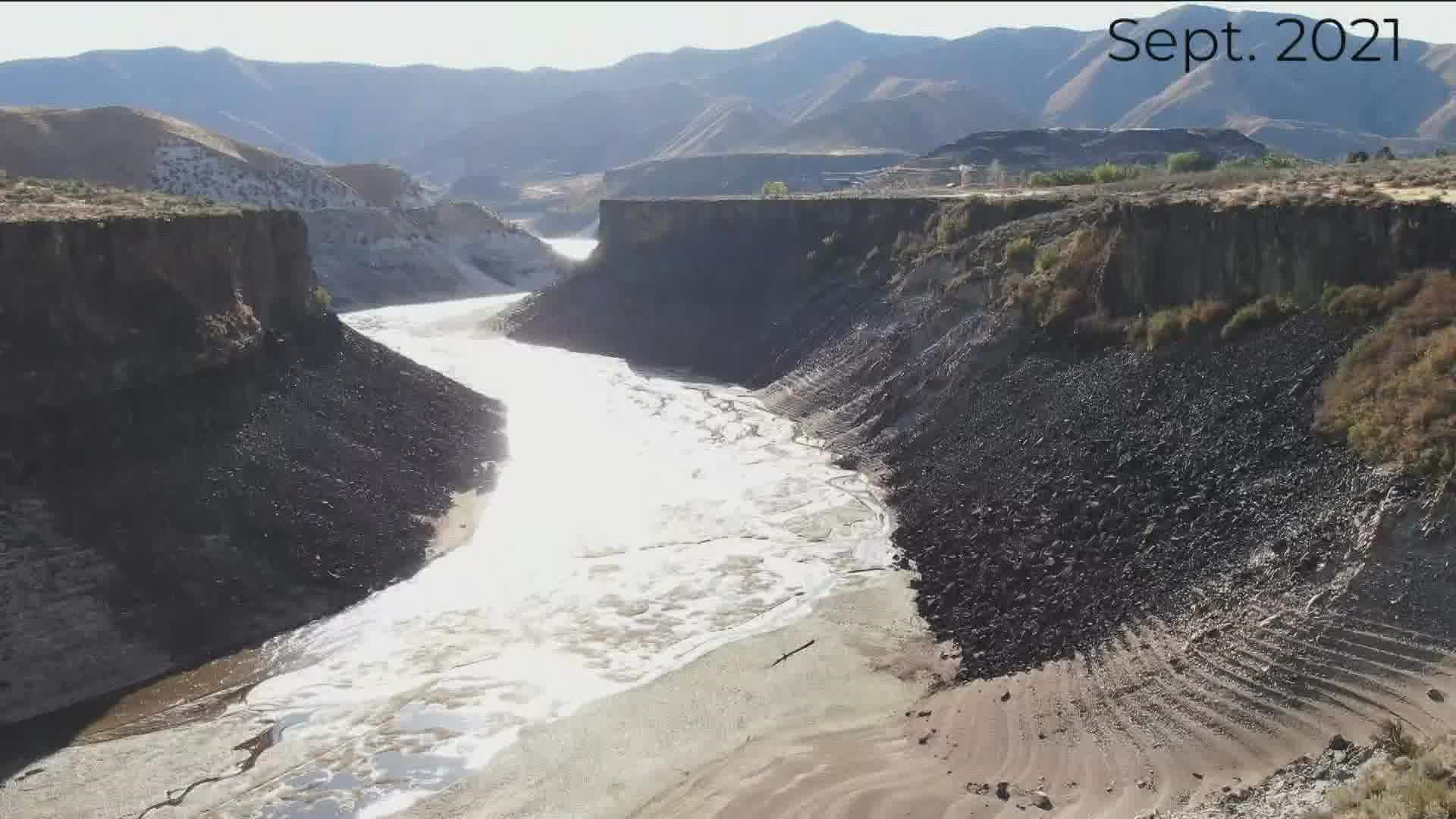BOISE, Idaho — For the second year in a row, the Boise River basin's water supply is well below normal. On Wednesday, the U.S. Army Corps of Engineers said that means the recreation season on Lucky Peak Reservoir may likely be shortened.
Flows from Lucky Peak Dam will continue at minimum releases of 220 cubic feet per second in order to conserve "as much water as possible" before irrigation season, expected to start later in April, the Corps of Engineers said.
Ryan Hedrick monitors the water and drought situation for the Bureau of Reclamation. In an interview with KTVB reporter Joe Parris, he said the dry situation last year helped set up the current drought reality.
"Carryover was low this year and so when you stack a low carryover year with, you know, a poor runoff year, cumulative on top of that," Hedrick said.
The National Weather Service reports precipitation totals for the water year beginning Oct. 1, 2021, and ending April 1, 2022, were 85 percent of normal. Seasonal snowpack was 65 percent of median. This follows a below-normal 2020-2021 water year, when nearly all of Idaho ended the water year in some level of drought and nearly 63 percent of the state was in "extreme" or "exceptional" drought. U.S. Drought Monitor data from March 29 indicates that this spring, more than 82 percent of Idaho already is in some kind of drought, ranging from "moderate" to "exceptional" -- D1 to D4 on a five-level scale that begins with D0, which indicates "abnormally dry," but not drought.
The low carryover from 2021, the low snowpack and precipitation this year, and other constraints on the system will make Lucky Peak difficult to fill. Regarding recreation, the Corps of Engineers said, "be aware of boat ramp accessibility with the potential for less water in Lucky Peak's reservoir this summer." More information about specific impacts to recreation will be released in future weeks, as spring runoff occurs. In 2021, the drawdown to the winter water level began weeks earlier than usual. An early drawdown in an already unusually low water year left some boats stuck on dry land by mid-August 2021.
Idaho Department of Water Resources hydrologist David Hoekema said predictions show that southern Idaho will experience widespread drought and water shortages this summer.
"Right now, we have severe drought up in the headwaters of the Boise River, out across the Central Mountains and pretty much everywhere roaming the Snake River Plain. We're expecting that this will probably become a severe drought within the next few weeks," Hoekema said
The drought and water situation has critical impacts on Idaho agriculture operations, they will be forced to make decisions on how to use limited resources.
"They will often reduce how much water they use throughout the year, and they'll be trying to save water as well. They'll be planting crops that aren't water heavy and in need of water. Probably not going to be a lot of corn or beets grown this year. So they're doing everything they can to try to get through this, these two tough years," Hedrick said.
The snowpack in Idaho's mountains is a major factor in this; the snowpack has declined since Jan. 9 in every basin south of the Salmon River, leaving the streamflow forecast to be 20 percent to 70 percent below average for the Snake River, Big Lost, Big Wood, Little Wood, Salmon Falls, Boise, Payette, and Weiser basins. The only slightly good news for agriculture: They had a feeling this was coming.
"This drought, unlike last year's drought, has been a long time and coming. And so we've had ample warning that the water supply conditions are looking rough. So I believe people will be a lot more prepared this season for the drought than they were last year," Hoekema said
Real-time flow rates recorded by the Bureau of Reclamation show that at 10:45 a.m. Wednesday, the Boise River flow rate at Glenwood Bridge, west of downtown Boise, was just over 258 cubic feet per second. That's below the 25th percentile for April 6, and less than half the median flow rate for that date, based on 40 years of water record.
Along with Lucky Peak Reservoir, the Corps of Engineers manages the Arrowrock and Anderson Ranch dams on the Boise River as a system for flood risk management and irrigation.
The drought will certainly be visible for Idahoans out on the Boise River system or up at Lucky Peak looking to recreate.
"Lucky Peak will be much lower than it normally is. It could be anywhere from 15 to 20 feet from full this year. And so we'll see drop offs on boat ramps and some of that may get affected," Hedrick said.
The Reservoir system in the Boise & Payette River Basins show Lucky Peak at 52 percent full, Anderson Ranch at 39 percent full, and Arrowrock at 89 percent full. To conserve water for agriculture operations, flows from Lucky Peak will be at minimum release, meaning the Boise River will be lower and slower for now.
There is hope that the upcoming summer months will be better than 2021, but the weather patterns will have a major impact on the situation in the coming weeks and months.
"We're not expecting a real hot summer like last year, but if we were to get that, the situation would degrade pretty quickly. And farmers could find themselves in a really rough spot, that was a one-in-a-hundred-year event. But sometimes those events come back to back. That doesn't mean we're going to wait another 100 years until we see the next one," Hoekema said.
Watch more Local News:
See the latest news from around the Treasure Valley and the Gem State in our YouTube playlist:

